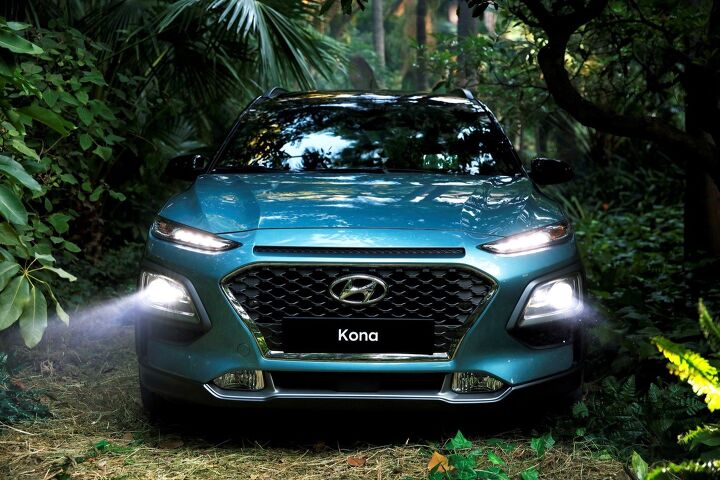2018 Hyundai Kona: Late But Not Too Late, Little But Not As Little As The Next One
Nearly seven years after the Nissan Juke. Five years after the Buick Encore. Three years after the Jeep Renegade. Two and a half years after the Honda HR-V. Finally, the 2018 Hyundai Kona is set to arrive as the fourth and smallest member of Hyundai’s utility vehicle lineup.
With the silhouette of a Mazda CX-3, the quirky light treatment of a Nissan Juke, and the cladding of a Pontiac Vibe, the Hyundai Kona will arrive in North America in early 2018 with optional all-wheel drive and a new platform that will be shared with the unfortunately named Kia Stonic.
The platform, Hyundai says, “is optimized to permit SUV levels of ground clearance.” Don’t expect more than 6.7 inches, yet in the Kona’s segment, the little Hyundai won’t actually be that low. But it is small. At 164 inches from bumper to bumper, the Hyundai Kona stretches only two inches longer than a Hyundai Accent hatchback and is four inches shorter than the Mazda CX-3.
Yet by 2020, Hyundai intends to strengthen its crossover lineup by positioning below the B-segment Kona an even smaller A-segment utility vehicle. Like a sidecar for your Santa Fe.
For the Kona, North American buyers are likely to have one or two choices. At the bottom of the lineup, a 148-horsepower 2.0-liter Atkinson-cycle engine works with a six-speed automatic. The 175-horsepower 1.6-liter turbo is joined to a seven-speed dual-clutch transmission. Hyundai’s only mention of a manual transmission is linked to the European market’s 1.0-liter turbocharged triple.
Suspension depends on the number of driven wheels. Front-wheel-drive Konas are limited to a torsion beam rear; all-wheel-drive Konas get a dual-arm multilink rear suspension.
Further to the many optional technical and safety advances you expect to see in new cars — auto high beams and lane keeping assist and the like — Hyundai will offer head-up display in the Kona. Unlike systems that project a picture onto the front windscreen, however, the Hyundai Kona will adopt Mazda’s oft-used technique of displaying content on a glass panel.
Hyundai eventually hopes to reveal a Kona EV for mass production with 242 miles. You’ll remember the range of the Chevrolet Bolt’s EPA-rated range: 238 miles. But first, the conventional 2018 Hyundai Kona must make its way to dealers. According to Wards Auto, Hyundai hopes to export more than 40,000 Korean-built Konas to Europe (mainly) and North America by the end of 2017, but plans to produce 150,000 Konas for export in 2018.
Hyundai Motor America is undeniably late to the subcompact crossover party, having denied itself the opportunity of selling the Hyundai Creta. Now-departed boss Dave Zuchowski said that decision cost Hyundai 18 months.
Now, as Hyundai gets ready to hop into the pool, the Kona will find that the water is deeper and many swimmers don’t want to make room for a small Hyundai to do a big cannonball. General Motors and Fiat Chrysler Automobiles own 52 percent of the category; Honda and Subaru another one-third. The category is growing. Not including the front-wheel-drive-only Kia Soul and Toyota C-HR, U.S. sales of subcompact crossovers are up 16 percent to nearly 218,000 units in 2017’s first five months. But in order to gain more market share in America’s growing SUV/crossover sector, the subcompact crossover category that doubled its volume in 2015 needs more contributors.
That’s where the Hyundai Kona and Ford EcoSport step up. Now we watch to see how they’re treated by their classmates.
Hyundai is in real need of some additional volume. “If you look at our sales, (they are) not faring as great as we expected,” Hyundai vice chairman Euisun Chung said at the Kona launch. If the Kona ranks among America’s subcompact crossover class leaders, Hyundai can expect roughly 7,500 monthly U.S. sales. That’s a start.
[Images: Hyundai]
Timothy Cain is a contributing analyst at The Truth About Cars and Autofocus.ca and the founder and former editor of GoodCarBadCar.net. Follow on Twitter @timcaincars.
More by Timothy Cain
Latest Car Reviews
Read moreLatest Product Reviews
Read moreRecent Comments
- V8fairy Not scared, but I would be reluctant to put my trust in it. The technology is just not quite there yet
- V8fairy Headlights that switch on/off with the ignition - similar to the requirement that Sweden has- lights must run any time the car is on.Definitely knobs and buttons, touchscreens should only be for navigation and phone mirroring and configuration of non essential items like stereo balance/ fade etc>Bagpipes for following too close.A following distance warning system - I'd be happy to see made mandatory. And bagpipes would be a good choice for this, so hard to put up with!ABS probably should be a mandatory requirementI personally would like to have blind spot monitoring, although should absolutely NOT be mandatory. Is there a blind spot monitoring kit that could be rerofitted to a 1980 Cadillac?
- IBx1 A manual transmission
- Bd2 All these inane posts (often referencing Hyundai, Kia) the past week are by "Anal" who has been using my handle, so just ignore them...
- 3-On-The-Tree I was disappointed that when I bought my 2002 Suzuki GSX1300R that the Europeans put a mandatory speed limiter on it from 197mph down to 186mph for the 2002 year U.S models.




































Comments
Join the conversation
These things have become comical parodies of themselves. "Let's sacrifice actual usable space and outward visibility for our sporty-utility-ness!" Nothing sporty and not so much utility about any of these things, and comic-book looks.
Don't know what you expect from someone that likes the Nissan Cube/Kia soul genre but I like it. Would like a small wagon or medium hatchback just as well. Guess I'm repeating myself.